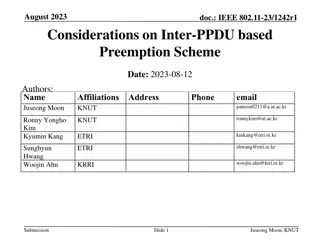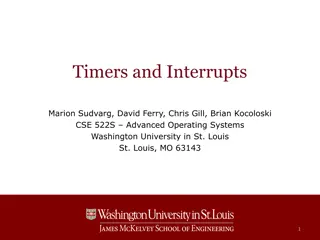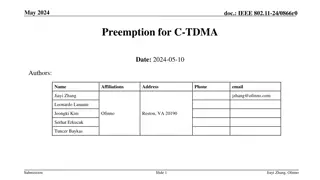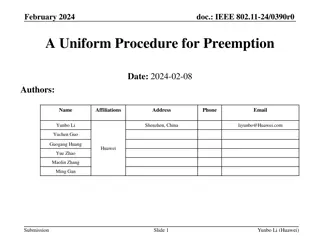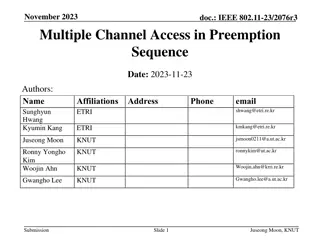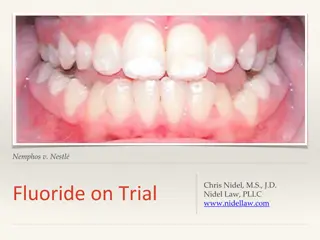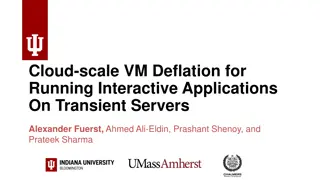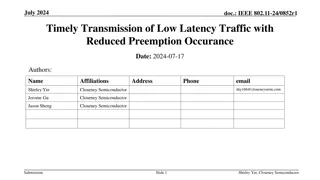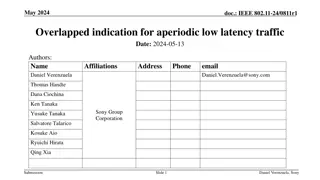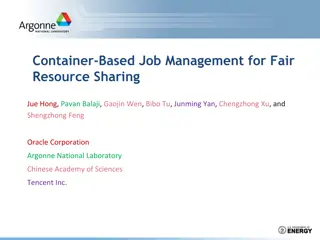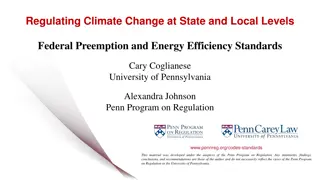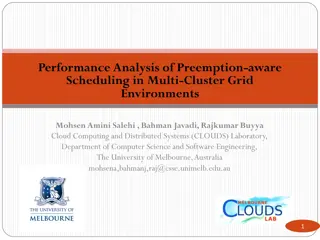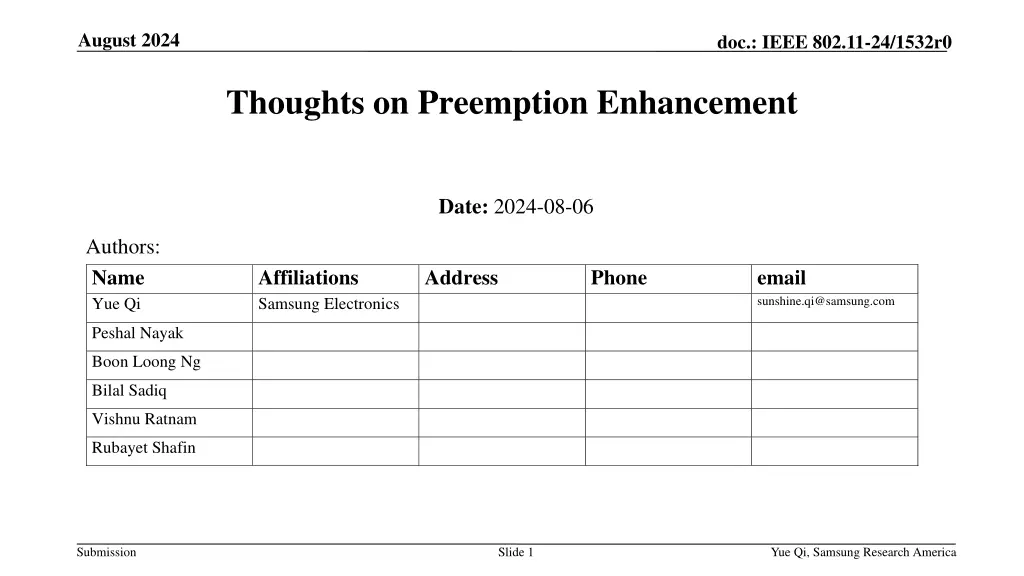
Enhancing Preemption in IEEE 802.11-24 Standard
Explore the insights and proposals for improving preemption in the IEEE 802.11-24 standard, authored by experts from Samsung Electronics. The document delves into potential enhancements to address current challenges effectively, offering valuable perspectives on this critical aspect of wireless communication technology.
Download Presentation

Please find below an Image/Link to download the presentation.
The content on the website is provided AS IS for your information and personal use only. It may not be sold, licensed, or shared on other websites without obtaining consent from the author. If you encounter any issues during the download, it is possible that the publisher has removed the file from their server.
You are allowed to download the files provided on this website for personal or commercial use, subject to the condition that they are used lawfully. All files are the property of their respective owners.
The content on the website is provided AS IS for your information and personal use only. It may not be sold, licensed, or shared on other websites without obtaining consent from the author.
E N D
Presentation Transcript
August 2024 doc.: IEEE 802.11-24/1532r0 Thoughts on Preemption Enhancement Date: 2024-08-06 Authors: Name Yue Qi Affiliations Samsung Electronics Address Phone email sunshine.qi@samsung.com Peshal Nayak Boon Loong Ng Bilal Sadiq Vishnu Ratnam Rubayet Shafin Submission Slide 1 Yue Qi, Samsung Research America
August 2024 doc.: IEEE 802.11-24/1532r0 Introduction The approved PAR intends to define at least one mode of operation capable of improving the tail of the latency distribution and jitter compared to Extremely High Throughput MAC/PHY operation [1]. Several contributions [2]-[6] propose and develop preemption mechanism as a candidate solution for supporting low latency transmission. In this proposal, we focus on the preemption and discuss: Scope and use cases in preemption Resource management operation Traffic protection in TXOP-based preemption Submission Slide 2 Yue Qi, Samsung Research America
August 2024 doc.: IEEE 802.11-24/1532r0 Latency requirements The latency requirements are different and the corresponding solutions can be specific. In this contribution, we focus on the first category in which the low latency traffic (LLT) is expected to be transmitted by the end of the TXOP. Analysis of feature requirement for LL applications [7] Range for delay tolerance d = delay tolerance, CA = legacy channel access delay Example values of d Example application categories Feature requirements Traffic may not survive when the current TXOP ends. Preemption can enable the transmission within the TXOP. Cloud gaming, AR/VR (e.g., remote surgery), live streaming services, high accurate industrial automation, etc. Few d TXOP limit 1. milliseconds Traffic may survive not being served in the same TXOP where it arrives but cannot incur a long channel access delay. Solution that can enable channel access faster than legacy channel access are needed [7]. AR/VR (e.g., multiplayer gaming), online gaming, some real time video applications, robotics. Close to 10 milliseconds TXOP limit < d CA 2. Video call, audio call, non-real time services such as streaming, web browsing, file downloads, etc. Few 10s of milliseconds CA delay << d Legacy channel access 3. Submission Slide 3 Yue Qi, Samsung Research America
August 2024 doc.: IEEE 802.11-24/1532r0 Use cases in pre-emption TXOP holder TXOP responder DL/UL TXOP, Traffic direction Preemptor (LL STA) LLT receiver LLT direction References Description TXOP holder preempts its own TXOP. Infra preempts infra. Case 1 AP STA1 DL, AP STA1 AP STA2 DL, AP STA2 [2,3] Case 2 AP STA1 DL, AP STA1 STA2 AP UL, STA2 AP [2-5] 3rd party preempts infra. Case 3 AP STA1 DL, AP STA1 STA2, STA3 AP UL, STA2&STA3 AP [2-5] 3rd parties preempt infra. Case 4 AP STA1 DL, AP STA1 STA2 STA1 P2P, STA2 STA1 -- Non-infra (P2P) preempts infra. TXOP responder preempts TXOP holder. Reversed TXOP. Case 5 AP STA1 DL, AP STA1 STA1 AP UL, STA1 AP mode 1, [6] Case 6 AP STA1 DL, AP STA1 STA1 STA2 P2P, STA1 STA2 mode 2, -- Non-infra (P2P) preempts infra. TXOP holder preempts its own TXOP. Non-infra (P2P) preempts infra. Case 7 STA1 AP UL, STA1 AP STA1 STA2 P2P, STA1 STA2 -- Case 8 STA1 AP UL, STA1 AP STA2 AP UL, STA2 AP [4,5] 3rd party preempts infra. Case 9 STA1 AP UL, STA1 AP STA2, STA3 AP UL, STA2&STA3 AP [5] 3rd parties preempts infra. Case 10 STA1 AP UL, STA1 AP STA2 STA1 P2P, STA2 STA1 -- Non-infra (P2P) preempts infra. Case 11 STA1 AP UL, STA1 AP AP STA2 DL, AP STA2 [4-6] Infra preempts infra. TXOP responder preempts TXOP holder. Reversed TXOP. Case 12 STA1 AP UL, STA1 AP AP STA1 DL, AP STA1 [5, 6] Case 13 AP STA1 UL trigger, STA1 AP STA2 AP UL, STA2 AP [8] 3rd party preempts infra. Case 14 AP STA1 UL trigger, STA1 AP STA2 STA1 P2P, STA2 STA1 -- Non-infra (P2P) preempts infra. Submission Slide 4 Yue Qi, Samsung Research America
August 2024 doc.: IEEE 802.11-24/1532r0 Use cases in pre-emption (Cont.) The use cases in one BSS can be classified into the following main categories: TXOP holder preempts its own TXOP. 3rd party(ies) preempt infra. Non-infra (P2P) preempts infra. TXOP responder preempts TXOP holder. AP STA3 (LL STA) STA2 (LL STA) STA1 How many use cases do we want to consider in 11bn? The most prioritized cases may be considered. Methods can be different from categories to categories and should not regress compared with the current performance. Preempting ongoing traffic should also be careful in case of their QoS requirement. Submission Slide 5 Yue Qi, Samsung Research America
August 2024 doc.: IEEE 802.11-24/1532r0 Problems Most of the preemption solutions may have an assumption that the LL traffic (LLT) should arrive after the start of the TXOP, and there is sufficient time so as to preempt successfully within the TXOP limit. However, there could be some cases that the LLT may not arrive in an ideal timing, thus, a better management from the TXOP holder is required. A: Backlog of LLT flows waiting for preemption. When there are some backlog of LLT in the queue and they do not win the channel access, and thus waiting for preemption, the TXOP holder may make some management for these LLT to achieve a better resource utilization and fairness. B: LLT flows arriving near the end of the TXOP seeking for preemption opportunities. For LLT backlog to the end and/or who may arrive late, may have to suspend or drop the traffic, which may result in a longer channel access delay. LLT flows backlog to the end Backlog of LLT flows waiting for preemption. LLT arriving late seeking for preemption. PPDU TXOP obtained by TXOP holder, T PPDU channel access delay Submission Slide 6 Yue Qi, Samsung Research America PPDU suspended
August 2024 doc.: IEEE 802.11-24/1532r0 Solution Overview (A) Enhancement A: A better management for backlog of LLT flows waiting for preemption. Preemptable TXOP: The duration of a preemptable TXOP is the time allowing a STA interrupts the control of the medium of the TXOP (the TXOP holder). Preemption window: can be defined as a duration during which preemption is allowed. TXOP holder may create some portion of the time as a window for preemption, i.e., preemption window; Other portion outside of the preemption window(s) can be scheduled for regular transmission. *Recap: TXOP definition [10.23.2.9]: The duration of a TXOP is the time a STA obtaining a TXOP (the TXOP holder) maintains uninterrupted control of the medium, and it includes the time required to transmit frames sent as an immediate response to TXOP holder transmissions. Submission Slide 7 Yue Qi, Samsung Research America
August 2024 doc.: IEEE 802.11-24/1532r0 Preemption window Preemption window features: LL STAs are allowed to preempt within a certain time window, i.e., during the preemption window. When the preemption window is over, the regular transmission can resume. The TXOP holder may decide to reopen the window for preemption. Multiple preemption windows (either separately or continuously) can be assigned for multiple STAs or LL traffic. In each preemption window, multiple STAs can be assigned into different resources such as frequency. Submission Slide 8 Yue Qi, Samsung Research America
August 2024 doc.: IEEE 802.11-24/1532r0 Example In the MAC/PHY header of the PPDU, a bit can indicate if preemption can start after this PPDU. For example, bit=1, open the window for preemption; bit=0, no preemption is allowed and the TXOP holder and responder can keep frame exchange. The Preemptable TXOP limits and preemption window can also be advertised by the AP in the EDCA parameter Set element in Beacon and Probe Response frames transmitted by the AP. Submission Slide 9 Yue Qi, Samsung Research America
August 2024 doc.: IEEE 802.11-24/1532r0 Solution Overview (B) Enhancement B: TXOP protection for late LLT preemption. Option 1: Extending TXOP. When the LLT or regular traffic needs to be finished within the TXOP, an indication of a longer duration protection can be considered to continue the transmission without contention. Option 2: Dynamic TXOP. Consider two TXOP duration constraints, and STAs can finish before the earlier limit. Otherwise, STAs can reach till the maximum TXOP duration limit for more time. Option 3: non-preemption window: The TXOP holder or responder can indicate a time that it will not allow preemption after it. Submission Slide 10 Yue Qi, Samsung Research America
August 2024 doc.: IEEE 802.11-24/1532r0 B: Preemption protection Option 1: Extending TXOP When preemption happens in the current TXOP, the TXOP holder can indicate a longer duration protection from T to T . The NAV timers for the nearby STAs can be reset. Option 2: Dynamic TXOP T is the first-class limit, and T is second-class limit. STAs are aware of both limits and adjust their capability. When there is no preemption or preemption finishes earlier before T , the TXOP holder can release the channel by sending CF-end frame. When there is preemption and more time is requested, the traffic can reach to the maximum duration limit of the TXOP. Option 3: non-preemption window The TXOP holder may indicate a time that LL STA(s) cannot preempt, e.g., toward the end of TXOP. The LL STA may decide either a transition to a high capability; or suspend to respect the current TXOP. Submission Slide 11 Yue Qi, Samsung Research America
August 2024 doc.: IEEE 802.11-24/1532r0 Summary Enhancing latency is one of a key objective in 11bn and preemption is a good solution to be considered. In this proposal, we discuss the scope and use cases in preemption. The resource management for backlog of LLT flows are considered. The TXOP protection for late LLT flows are revealed. Submission Slide 12 Yue Qi, Samsung Research America
August 2024 doc.: IEEE 802.11-24/1532r0 References [1] 11-23/480r3, UHR Proposed PAR [2] Intel, 11-23-0092-00-0uhr-pre-emption [3] Intel, 11-23-1229-00-0uhr-preemption-for-low-latency-application-follow-up [4] NXP, 11-23-1174-00-0uhr-txop-preemption-follow-up [5] Huawei, 11-24-0390-00-00bn-a-uniform-procedure-for-pre-emption [6] apple, 11-24-0389-00-00bn-preemption-for-low-latency [7] 11-24-0733-00-00bn-considerations-for-low-latency-application-support-in-next-generation-wlans [8] 11-24-0442-03-00bn-latency-reduction-for-immediate-real-time-application-traffic-transmission Submission Slide 13 Yue Qi, Samsung Research America




